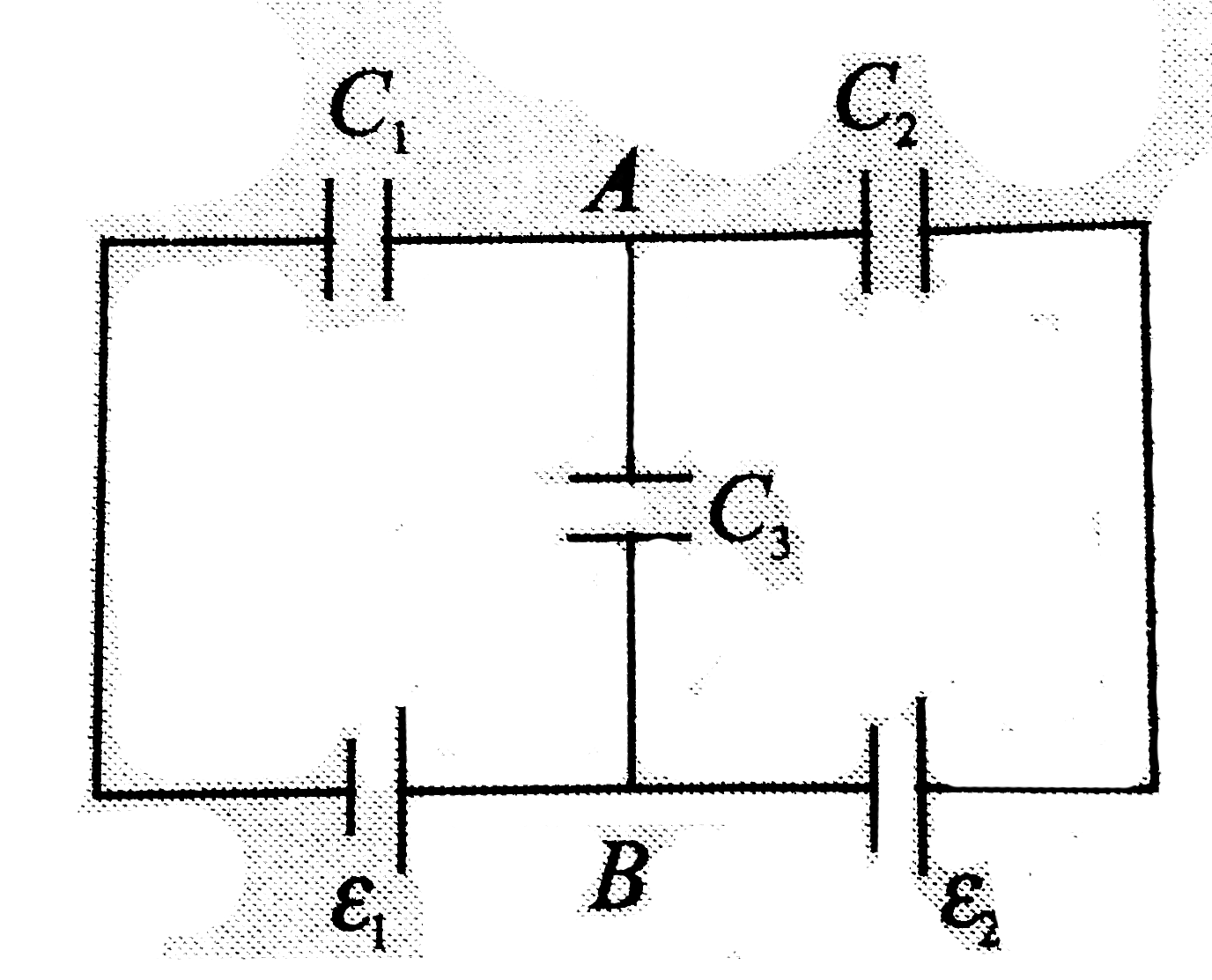Find the potential difference VA−VB between points A and B of the circuit shown in.
 .
.
Video Solution
Text Solution
Method 1: The distribution of electric charge is shown in Fig. 4. 78.
 .
.
In loop (1) ,
ε1−q1C3−qC1=0 (i)
In loop (2),
−(q−q1C1)+q1C3+ε2=0 (ii)
Solving Eqs. (i) and (ii), we get
q1=−C3(C2ε2−C1ε)(C1+C2+C3)
∴VA−VB=−{q1C3}=(C2ε2−C1ε1C1+C2+C3)
Method 2: The algebraic sum of the charge at junction A should be zero . suppose the chartes q1,q2,andq3 are moving away from the junction. Let us assume that potential of unction B is zero . Now we will write the potentials of various junctons as shown in. After knowing the potential difference across the capacitors. we can weite relations of q1,q2 and q3 in terms of their capacitance and potential differece.

At junction (A),
∑q=0
or q1+q2+q3=0
or C1(x+ε1)+C2(x−ε)+C3(x−0)=0
or x(C1+C2+C3)=ε2C2−ε1C
∴x=ε2C2−ε1C1C1+C2+C3
:.VA+VB=x−0=x=ε2C2−ε1C1C1+C2+C3
Method 3: The electric charge enclosed by the isoated system shown in. should be zero. Therefore,
q1+q2+q3=0
or x+ε1C1+x−ε2C2+x−0C3=0 or x=C2ε2−C1ε1C1+C2+C3
∴VA−VB=x−0=C2ε2−C1ε1C1+C2+C3
|
Topper's Solved these Questions
- CAPACITOR AND CAPACITANCEBook:CENGAGE PHYSICSChapter:CAPACITOR AND CAPACITANCEExercise:Solved Examples
Explore 10 Videos
- CAPACITOR AND CAPACITANCEBook:CENGAGE PHYSICSChapter:CAPACITOR AND CAPACITANCEExercise:Exercise 4.1
Explore 13 Videos
- ATOMSBook:CENGAGE PHYSICSChapter:ATOMSExercise:QUESTION BANK
Explore 40 Videos
- CENGAGE PHYSICS DPPBook:CENGAGE PHYSICSChapter:CENGAGE PHYSICS DPPExercise:subjective type
Explore 51 Videos
Similar Questions
Knowledge Check
The potential difference VA−VB between points A and B for the circuit segment shown in figure at the given instant is
 A12VB−12VC6VD−6V
A12VB−12VC6VD−6VThe potential difference between points A and B in the circuit shown in fig. 5.317 is 16V. Then
 Athe current through the 2Ω resistance is 3.5ABthe current through 4Ω resistance is 2.5ACthe current through 3Ω resistance is 1.5ADthe potential difference between the terminals of the 9V battery is 7V
Athe current through the 2Ω resistance is 3.5ABthe current through 4Ω resistance is 2.5ACthe current through 3Ω resistance is 1.5ADthe potential difference between the terminals of the 9V battery is 7VThe potential difference (VA−VB) between the point A and B as shown in the figure is
 A9VB8VC15VD13V
A9VB8VC15VD13V
Find the potential difference (inV) between points A and B shown in the circuit.

View SolutionIn the circuit shown in figure four capacitors are connected to a battery. Determine the potential difference VM−VN between· points M and N of the circuit. Find the conditions under which it is equal to zero.

View SolutionFind the potential difference between the points A and B in the circuit shown in Fig. 4.66. Internal resistances of the cells are negligible.
View SolutionThe potential difference (VA−VB) between the point A and B in the given figure is :

View SolutionThe potential difference (VA−VB) between the point A and B in the given figure is :

View Solution


